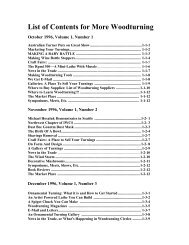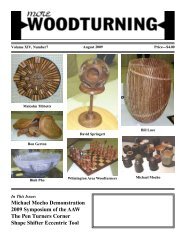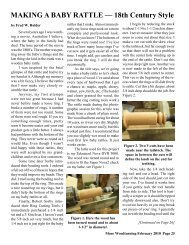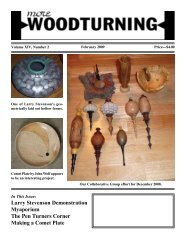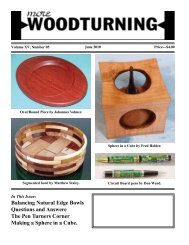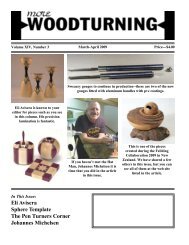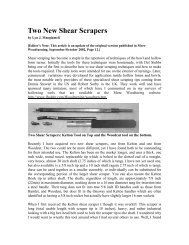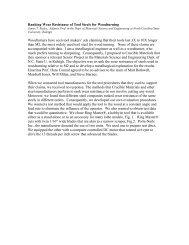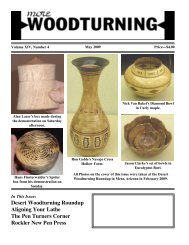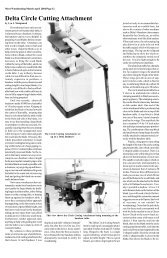Robust Lathe Review - More Woodturning
Robust Lathe Review - More Woodturning
Robust Lathe Review - More Woodturning
You also want an ePaper? Increase the reach of your titles
YUMPU automatically turns print PDFs into web optimized ePapers that Google loves.
Testing andCertification of LeadContent in Children’sProductsSource: AAW Web Site Comment:The Consumer Product Safety ImprovementAct of 2008 is scheduledto go into effect in February, andmay impact some woodturnersability to make/sell children’s toys.Here’s the Government’s “Statementof Policy” - providing much neededclarification on administration ofthis new law.This statement of policy is issuedby the Commission to provideguidance on the testing and certificationof children’s products forcompliance with the lead contentlimits established in the ConsumerProduct Safety Improvement Act of2008 (“CPSIA”). The Commissionhas received a number of questionson compliance with the new leadlimits.This document, which has beenapproved by the Commission, providesguidance. It does not imposelegal requirements beyond thosealready contained in the CPSIA orother agency regulations.We have received several questionsasking us to explain a recentCommission determination thatcertain materials will not exceedthe lead limits. (The determinationappeared in a final rule that waspublished in the Federal Registeron August 26, 2009 (74 Fed. Reg.43031)). We also have receivednumerous questions on componenttesting.We address those issues usingplain language to make it easierfor readers to understand our approach.A. What does the lead contentlaw require?The CPSIA provides that productsdesigned or intended primarilyfor children 12 years old andyounger (“children’s products”)cannot contain more than 300 partsper million (ppm) of lead in anyaccessible part. We call this a 300ppm “lead content limit.”This new lead content limitshould not be confused with theCommission’s 90 ppm limit on leadin paint used on certain productssuch as furniture and children’stoys.B. How and when must children’sproducts be tested andcertified to the 300 ppm leadcontent limit?Children’s products will needto be tested for compliance withthe 300 ppm lead content limit. Thetests must be done by a third partyconformity assessment body (morecommonly known as a third partylaboratory) and, based on thosetests, certified as compliant. Thethird party laboratory must be accreditedand the accreditation mustbe recognized by CPSC. A listingof CPSC-recognized laboratoriescan be found at http://www.cpsc.gov/cgi-bin/labapplist.aspx. Formore information on who needsto certify children’s products forcompliance, please see http://www.cpsc.gov/businfo/frnotices/fr09/certification.pdf.The Commission has postponedthe requirement to begintesting and certification to the 300ppm lead content limit; therefore,we do not require such testing andcertification until February 2010,at which time the Commission willvote on the stay.Companies, however, may notdistribute or sell children’s productsthat exceed the 300 ppm lead contentrequirement in the law. Thereare, however, two exceptions withrespect to lead testing and certification:(a) lead in paint; and (b) leadin children’s metal jewelry. Testingand certification of products subjectto the 90 ppm limit on lead in painthas not been postponed. <strong>More</strong>over,the Commission has not postponedthe requirement for testing and certificationof children’s metal jewelryto the 300 ppm lead content limit.C. What is a children’s productthat must be tested for leadcontent?The Commission is often askedwhat products must comply withthe lead content limit, i.e., what isa “children’s product” under thelaw. The answer is anything that isdesigned or intended primarily fora child 12 years of age or younger.“Primarily” is the key word used inthe law. Not everything a child usesor touches must meet the lead contentlimit, only those things designedor intended primarily for a child 12years old or younger. The Commissionlooks at each product on a caseby-casebasis. We consider how theproduct is marketed as well as whatthe manufacturer has said about theproduct (if reasonable) and whetherconsumers commonly recognizethe product as being intended for achild 12 or younger. For example,the Commission has previously saidthat an ordinary ball point pen is notprimarily intended for children, andmost consumers would not consideran ordinary ball point pen as beingintended primarily for use by a child12 years of age or younger. We real-[Continued on Page 34.]<strong>More</strong> <strong>Woodturning</strong> February 2010 Page 29



